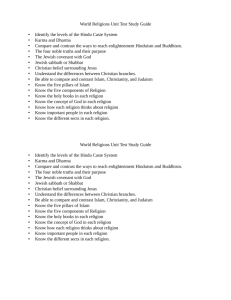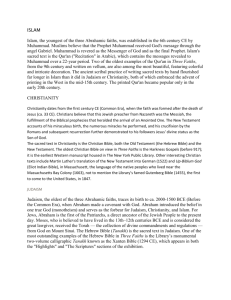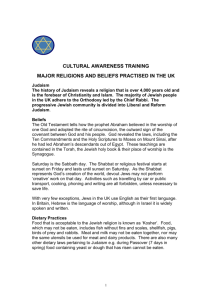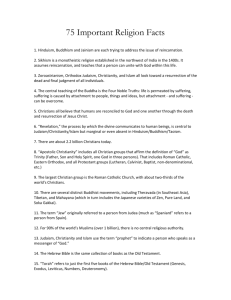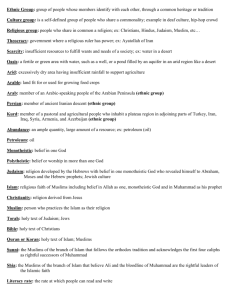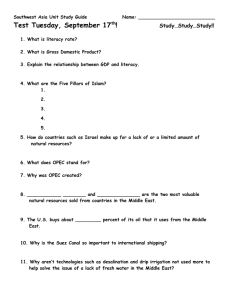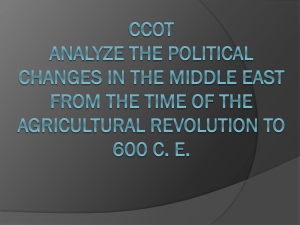Story Sacks - The Farmington Institute
advertisement
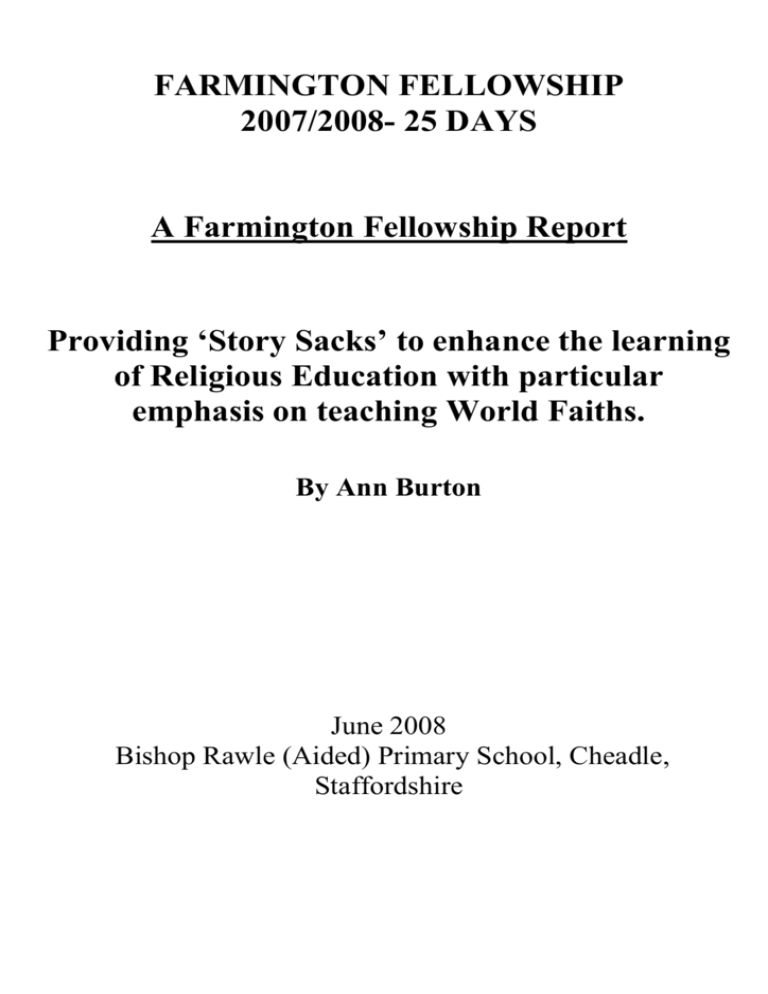
FARMINGTON FELLOWSHIP 2007/2008- 25 DAYS A Farmington Fellowship Report Providing ‘Story Sacks’ to enhance the learning of Religious Education with particular emphasis on teaching World Faiths. By Ann Burton June 2008 Bishop Rawle (Aided) Primary School, Cheadle, Staffordshire INTRODUCTION-Why this study? My name is Ann Burton and I am a teacher at Bishop Rawle Church of England Primary School in Cheadle, Staffordshire. My main aim was to improve the children’s experience of other faiths and to counteract the general negative attitudes of the children about other faiths and cultures I have been teaching for 16 years and ‘inherited’ the post of Religious Education co-ordinator seven years ago. I have no formal qualifications in RE, except an interest in the subject and a firm Christian faith, and in primary schools, if you are ‘religious’ you seem to get landed with the job! Although confident when dealing with all things ‘Christian’, I felt lacking in knowledge and confidence when dealing with ‘other’ faiths. Within the pyramid of schools in which I work, the two world faiths we teach are Islam and Judaism. Due to my own lack of confidence I was hardly an inspiration to other teachers who were expected to deliver this as part of the curriculum. I had no problem developing planning and knew what ‘should’ be done, but had no real subject knowledge. The Farmington Fellowship has given me the opportunity to develop my personal understanding and knowledge of world faiths, and to develop the teaching strategies in school. My main aim was to improve the children’s experience of other faiths and to counteract the general negative attitudes of the children about other faiths and cultures BISHOP RAWLE SCHOOL BACKGROUND We are an average size Church Aided primary school with 220 pupils on role. We are in a rural setting, and quite isolated from other large communities. There is only 1 child who does not have English as the main language. There are a handful of children, perhaps eight, who come from actively Christian homes or who attend church regularly. There are no other religions represented in the school among either children or staff. Some children from our area never move outside it, except on school trips. Many adults have been born and brought up locally and are not familiar with other parts of Stoke, far less the rest of the United Kingdom. The nearest large town is 12 miles away, and this has a relatively small Muslim community, with even less Jewish people. All the staff are white, and the majority are practising Christians. The children come from mainly low socio-economic backgrounds and inherit a lot of prejudices from their parents. The parents are generally un-supporting of any activities or visits concerning faiths other than Christianity. The problems we experience in our mono-cultural school are similar to those high lighted in national OFSTED reports: • Teachers and co-ordinators lack knowledge and understanding of non-Christian religions. • Teachers lack confidence when teaching RE • Lack of resources and information about suitable artefacts and teaching materials • The lack of plurality in the children’s religious backgrounds that leads to no natural contacts with any faith community other than Christianity • The every day relevance of RE to young children. MY FARMINGTON PROJECT Because of the situation of our school, multi-faith RE is all the more important as the children have no personal contact with non-Christian faith communities. The implications of living in a multi-faith society will have increasing significance as they grow older. The main aim of my project was to try and make the teaching of world faiths a positive learning experience, rather than a ‘chalk and talk’ lesson to be done as quickly as possible then ticked off the sheet! SUMMARY OF KEY OBJECTIVES: • To develop the teaching of World Faiths other than Christianity by having medium and short term planning with clear progression. • To provide resources to provide a multi-sensory learning experiences for Key Stage one children. • To use resources to make the subject ‘real’ to young children, allowing interaction and handling of artefacts outside their experience. • To develop ‘Exponential learning’- Immersion in the theme or experience • Resources that can be used independently or as part of Key Stage 2 curriculum. • To allow non specialist teachers to deliver lessons about non Christian Faiths and develop secure knowledge. • To make contact with members of non-Christian faith communities to enhance learning with visits or visitors I decided to base my project on multi-sensory learning, an approach I found to work well with young children in all curriculum areas. Multi-sensory learning techniques are key to teaching children because all the pathways in the brain are being used. Because all learners are different, a variety of approaches ensures weak senses are supported by the strong ones. The key feature of multi-sensory teaching is to involve simultaneous input from visual, auditory, tactile and kinaesthetic channels. We remember 20% of what we read, 30% of what we hear, 50% of what we say, 60% of what we do and 90% of what we see, hear, say and do! (Staffordshire SENSS publication on multisensory teaching and learning) This theory is backed up by extensive research: The BERA Academic Review ‘Early Years Research: Pedagogy, Curriculum and Adult Roles, Training and Professionalism’ (1993) found that when information is delivered to young children, only one third of them will be able to learn it. This is because only one third of the population acquire information through their ears. Unless there is some impairment, we use all our senses to take in information. After the age of four, we take most of our ‘school’ information through three of our senses, known in NLP as Visual, Auditory and Kinaesthetic. Every individual shows a preference for only one or two of these. Children who prefer Auditory learning usually do quite well in the school system as ‘teacher talk’ is the main form of imparting information. \children who prefer visual learning also do quite well, particularly in primary school. The group who miss out the most are the ones who prefer to learn kinaesthetically. Kinaesthetic learning encompasses more than the sense of touch. It also includes a need to move and to be touched emotionally. It often refers to all the children who are swinging and fidgeting on their chairs. Colours, images, shapes, sounds, textures and tastes all contribute to the world of religious experience Later, children will be able to find out how the things they see, hear, touch, taste and smell can all be meaningful, but if they are to do it, they must start here. (Smith, 1990, page 48) To ensure the children have the best possible RE education, I want to teach children Religious Education using multi-sensory strategies so that learning is: • Auditory- the children begin as ‘listeners’ then progress to become the ‘tellers’. The teacher has to start as the ‘teller’ but should gradually withdraw to become the ‘listener’. • Visual- provide a visual format of the information, using puppets, artefacts, pictures and moving images to help the children internalise the information. • Cognitive- emphasising ‘connectives’ helps children to store information. (handling artefacts while listening to information) • Kinaesthetic-simple actions linked to information to secure learning.(acting out) “If they can’t learn the way we teach, we must teach the way they learn” (H. Chasty 1987) STARTING POINT • I started with formative assessment-what do they know about other faiths? The children throughout school were given a questionnaire to complete. (SEE APPENDIX) • From the results it was clear that despite previous teaching, the children had very limited understanding of other faiths and actually had some very racist ideas. Comments about Muslims included: • They eat funny food • They live in other countries • They cover their faces because they don’t like people looking at them • They believe in lots of God’s • They don’t talk English There were also lots of encouraging comments from the children: • I wish we had some Muslim children in school so we could learn all about their faith • It is good for all the children in the world to get to know each other • All children should learn together • It is a good thing to find out about what other people believe in • I think most people are good even if they have different God’s I decided to start with Islam and Judaism, as these are the two World Faiths taught within the school pyramid and so would be a good resource to lend out to the other primary schools, although I quickly widened my project to include Hindu festivals and Christianity. The ‘story sacks’ would provide: • Artefacts for the children to handle. • Background information for teachers. • Worksheets to cover different age ranges. • Power-point presentations for use on interactive whiteboards. • A list of web based resources to support learning. • I also expanded the project to include Christian resources due to the grants I obtained and listed above. HOW TO FUND THE PROJECT • Due to falling numbers, the school has had to make compulsory redundancies, so no budget has been allocated to RE. • Any money needed to fund the project would have to be obtained by fund raising events. • Part of the Fellowship time was spent on organising events with the pupils, from which we managed to raise £320. • From this money I had to buy books and artefacts for the story sacks • I applied to two Religious charities for funding and had two grants • £300 from the Howard Johnson Trust (See appendix for full list of items purchased) • £250 from the Jerusalem Trust (See appendix for full list of items purchased) • These were for Christian books and artefacts so I was able to expand my initial project to include Christian story sacks, so decided to do Noah, Christmas, Creation, Harvest, The Christian Church and Prayer. The main part of the project was practical, making the ‘story sacks’ and collecting the artefacts for the children to use. I also made a resource file for each bag which included: • Background teacher information • Pictures • Lesson ideas and worksheets covering Key Stage 1 and Key Stage 2 • Medium term lesson plans worksheets • A selection of power point presentation relevant to each theme. • A resource CD with information that can be sent to other teachers The full list of ‘Story Sacks’ are listed below: Islam: • The Mosque / The Quran • Ramadan / Eid Judaism: • The Synagogue / The Torah • Jewish Festivals and Celebrations Hindu: • Diwali • • • • Christian: Noah Harvest Christmas The Church / Christian Prayer All Faiths: • Creation Stories The following pages list the resources in each sack and give basic background information on Islam and Judaism. RESOURCES FROM THE STORY SACK ON JEWISH FESTIVALS AND CELEBRATIONS. List of resources for Jewish Festivals and Celebrations • • • • • Hanukkah Lights-book KS 1 World of Festivals Taste of winter-story of Hanukkah DVD- Hanukkah Dreidel • Wooden Sabbath set • Big book-A day to Remember • Hannukhai and candles • • • • Purim finger puppets Purim card Purim set Grogger • We love Passover • Rebecca’s Passover • World Faith jig-saw • PowerPoint presentation • Picture file • Resource file –worksheets/information • Resource CD Useful web pages-Chanukah http://www.bbc.co.uk/schools/religion/judaism/hanukkah.shtml http://www.ort.org/ort/edu/festivals/hanukkah/index.html http://www.ers.north-ayrshire.gov.uk/judaism.htm http://www.hitchams.suffolk.sch.uk/synagogue/chanukah.htm http://www.torahtots.com/holidays/chanuka/chanstr.htm http://www.jewish.co.uk/festivals.php3#Chanukah http://www.akhlah.com/holidays/hanukkah/hanukkah.asp http://www.jajz-ed.org.il/festivls/hanuka/hanukah.html Passover: http://www.passover.net/ http://www.jewish.co.uk/festivals.php3#Passover http://www.akhlah.com/holidays/pesach/passover.asp . Purim http://www.jewish.co.uk/festivals.php3#Purim http://www.akhlah.com/holidays/purim/purim.asp www.holidays.net/purim Information and activities about Purim Rosh HaShanah http://www.jewish.co.uk/festivals.php3#Rosh%20Hashanah http://www.akhlah.com/holidays/roshhashana/RoshHashannah.asp http://www.jajz-ed.org.il/festivls/tish/rosh.html Shavuot http://www.jewish.co.uk/festivals.php3#Shavuot http://www.akhlah.com/holidays/shavout/shavout.asp http://www.jajz-ed.org.il/festivls/shavuot/2.html Yom Kippur http://judaism.about.com/library/holidays/higholidays/bl_yk.htm http://www.akhlah.com/holidays/yomkippur/YomKippur_traditions.asp http://www.jajz-ed.org.il/festivls/tish/kippur.html Shabbat http://www.aish.com/shabbatfamily/ Activities for all ages-Shabbat USEFUL WEB LINKS ON JUDAISM http://www.reonline.org.uk/allre/tt_nframe.php?http://www.hitchams.suffolk.sch.uk/synagogu e/index.htm Virtual tour and on-line activities http://www.reonline.org.uk/allre/tt_nframe.php?http://www.ngflcymru.org.uk/vtc/ngfl/re/m_parry_carmarthenshire/e_index_synagogue_old.htm Information and pictures about a Synagogue in Wales http://www.reonline.org.uk/allre/tt_nframe.php?http://atschool.eduweb.co.uk/carolrb/judaism/ judai1.html Judaism for children-general information http://www.reonline.org.uk/allre/tt_nframe.php?http://www.shamash.org/reform/uahc/congs/n j/nj006/seder/plate.html Virtual Seder plate http://re-xs.ucsm.ac.uk/re/places/synagogu.htm On-line Synagogue tour http://www.wellesley.mec.edu/wms/hamilton/Virtual_Synagogue/pages/Synagogue.htm On-line Synagogue tour-better for older children http://atschool.eduweb.co.uk/carolrb/judaism/judai1.html General information http://www.woodlands-junior.kent.sch.uk/Homework/religion/jewish.htm Nice information site for Key Stage 1 http://www.ers.north-ayrshire.gov.uk/judaism.htm Good link site for all aspects of Judaism http://www.cleo.net.uk/resources/index.php?ks=1&cur=15 On-line white board resources http://www.reonline.org.uk/allre/tt_nframe.php?http://www.strath.ac.uk/curricularstudies/soci alstudies/re/db/reartefacts/jewish/ Pictures and information about artefacts STORY SACK BASED ON THE SYNAGOGUE AND THE TORAH List of resources for Jewish Synagogue and Torah • Synagogue soft play set • Rabbi doll • Kibbah hat • Torah scroll • Poster-The Ten Commandments • Poster-Inside a Synagogue • Menorah • Big book-Visiting a Synagogue • Big book-My Jewish Faith • I am a Jew • The Jewish Faith • Moses • Judaism • Jewish Prayer and Worship USEFUL WEB PAGES ABOUT SYNAGOGUES Virtual Synagogue/information http://www.reonline.org.uk/allre/tt_nframe.php?http://www.hitchams.suffolk.sch.uk/synagogu e/index.htm Information and pictures of key features in a Synagogue. http://www.reonline.org.uk/allre/tt_nframe.php?http://www.ngflcymru.org.uk/vtc/ngfl/re/m_parry_carmarthenshire/e_index_synagogue_old.htm Judaism for children http://www.reonline.org.uk/allre/tt_nframe.php?http://atschool.eduweb.co.uk/carolrb/judaism/ judai1.html Virtual tour of a Synagogue http://re-xs.ucsm.ac.uk/re/places/synagogu.htm Virtual tour of a Synagogue http://www.wellesley.mec.edu/wms/hamilton/Virtual_Synagogue/pages/Synagogue.htm Virtual tour and information http://atschool.eduweb.co.uk/carolrb/judaism/judai1.html Information in child –friendly format http://www.woodlands-junior.kent.sch.uk/Homework/religion/jewish.htm General information and links about Judaism http://www.ers.north-ayrshire.gov.uk/judaism.htm Virtual tour of a Synogogue http://www.hitchams.suffolk.sch.uk/synagogue/index.htm On-line activity site for kids http://www.bje.org.au/kids/templateFolder.php?id=20&gid=2 Matching words to artefacts-on-line activity http://www.crickweb.co.uk/assets/resources/flash.php?&file=match Background information and basic concepts of Judaism Rabbinical View Judaism believes that God created the world for the purpose of having people upon whom to bestow kindness. He gave us commandments in order that they should deserve the kindness he bestows and that it not be charity. He created Adam and Eve and gave them only one commandment which they transgressed and thus were deserving of death, however, because they repented, their death was delayed. As time went on, although there were always righteous people, the vast majority denied God's authority. God sent Noah to build an ark so that the world would see and repent, but when they did not do so, he brought a flood and destroyed the world, leaving only Noah and his children whom he gave seven commandments. Although Noah's son Shem and Shem's grandson Ever remained righteous and maintained a yeshiva for the purpose of teaching Torah, the vast majority of the world began to worship idols. Abraham, although born in a world of idol worship, determined that there must be a single power who is in control of the world whereupon God made himself known to him. Abraham dedicated his life to denouncing idolatry. This is why he is called the first Jew; he was the first to take on the world and proclaim the folly of idolatry. As a result, God promised he would have children from Isaac who would carry on his work and inherit the land of Israel (then called Canaan) after having been exiled and redeemed. As such, he gave Isaac's son Jacob the title Israel, and dedicated his children to be his nation. He sent Jacob and his children to Egypt, and after they had been enslaved, he sent Moses to redeem them from slavery, take them to Mount Sinai, give them the Torah which is comprised of 613 commandments, and take them to the land of Israel. God Judaism is a monotheistic religion. Jews believe there is one God who created and rules the world. This God is omnipotent (all powerful), omniscient (all knowing) and omnipresent (in all places at all times). God is also just and merciful. People It is believed that each person is created in the image of one God. Therefore, all people are created equal. Furthermore, our likeness to God is in our intellectual ability to understand. Judaism believes that people have freewill and are responsible for the choices made. Judaism is an ethical religion. When the Israelites accepted the Ten Commandments from God at Mount Sinai, they committed themselves to following a code of law which regulates both how they worship God and how they treat other people. Holy Book The Torah is the primary document of Judaism. Torah, which means "teaching", is God's revealed instructions to the Jewish People. Jews learn from the Torah how to act, think and even feel about life and death. The stories in the Torah teach about God's relationship with the Jewish People. In addition, the Torah contains 613 commandments from God (mitzvot). The Ten Commandments are considered the most important commandments of the Torah. The Ten Commandments 1. 2. 3. 4. 5. 6. 7. 8. 9. 10. I am the Lord your God You shall not recognize the gods of others in My presence You shall not take the Name of the Lord your God in vain Remember the day of shabbat to keep it holy Honor your father and your mother You shall not murder You shall not commit adultery You shall not steal Do not give false testimony against your neighbor You shall not covet your fellow's possessions Land Judaism believes the Land of Israel (Eretz Yisrael) was part of the covenant made between God and the Jewish People at Mount Sinai. Since the time of Abraham, there has been a continual Jewish presence in the Land of Israel. Messiah Jews believe the Messiah (Mashiach) will be a person (not a god), from the family of King David, who will lead the world to unity and peace. Jews do not believe that Jesus was the Messiah. Summary of Basic Principles of Judaism Rambam's thirteen principles of faith is the most widely-accepted list of Jewish beliefs. 1. 2. 3. 4. 5. 6. 7. 8. 9. 10. 11. 12. 13. God exists. God is one and unique. God is incorporeal. God is eternal. Prayer is to be directed to God alone. The words of the prophets are true. Moses was the greatest prophet, and his prophecies are true. The Torah was given to Moses. There will be no other Torah. God knows the thoughts and deeds of men. God will reward the good and punish the wicked. The Messiah will come. The dead will be resurrected. Resources for story sack on The Mosque and Qur’an List of resources for the Mosque and the Qur’an • • • • • • • • • • • • • • • • • • Quran and stand Prayer mat Compass Prayer beads Topi and Hajib Sari Poster- Life of Muhammad Poster- Five pillars of Islam Poster- Inside a Mosque Poster-5 duties of Islam Poster-Prophets of Allah Five pillars of Islam-soft play book Book set-12 stories from the Quran Big book-My Muslim Faith Big book-Visiting a Mosque (also small book) Folens ideas bank-Islam I am a Muslim-book Muslim Prayer and Worship-book • PowerPoint presentation • Picture file • Resource file –worksheets/information • Resource CD Useful websites for information and virtual tours of Mosques • http://www.woodlandsjunior.kent.sch.uk/Homework/religion/Islam.htm#Mosque General information on Islam presented in child-friendly format. • http://atschool.eduweb.co.uk/carolrb/islam/mosques.html Information for children • http://www.ngfl.ac.uk/re/hanfia1.htm Virtual tour of a Mosque • http://www.ngflcymru.org.uk/vtc/ngfl/re/m_parry_carmarthenshire/e_index_mosque_old.ht m Very useful site for information about a Mosque and the rituals of prayer • http://www.hitchams.suffolk.sch.uk/mosque/default.htm Virtual tour and general information • http://www.bgfl.org/bgfl/custom/resources_ftp/client_ftp/ks1/re/teddys_day_ out/index.htm Covers several faiths. Very suitable for young children. • http://www.islam4schools.com/ Games and activities. Example of the call to prayer • http://www.schooltrain.info/re/muslim/muslim_choose.htm • General information. Useful for children to research Islam • http://www.jannah.com/learn/flashprayer1.html Video explaining the prayer rituals used by Muslims • http://www.reonline.org.uk/allre/tt_nframe.php?http://www.strath.ac.uk/curricularstudie s/socialstudies/re/db/reartefacts/islam/ Pictures of Islamic artefacts Resources for story sack on Ramadan and Eid List of resources for Ramadan/ Eid • Qur’an and stand • Prayer mat (Childs) • Boy and girl Muslim doll • Topic and Hajib • Sari/head scarf • Mahanadi design book and henna paint • Islamic pattern book • Ramadan Mubarak DVD • Big book-Story of Muhammad • Muslim poems for children • Will you come on Wednesday-Eid? • World of Festivals-Ramadan • World of Festivals-Id-ul-Fitr • PowerPoint presentation • Picture file • Resource file –worksheets/information • Resource CD USEFUL INTERNET LINKS ON RAMADAN AND EID http://www.bbc.co.uk/schools/religion/islam/ramadan.shtml Information for teachers and suggestions for activities linked to QCA units http://www.kiddyhouse.com/Ramadan/ Information for children and suggested links for teachers. http://www.holidays.net/ramadan/ Information more suitable for older children http://atschool.eduweb.co.uk/carolrb/islam/links.html Islam for children http://www.reonline.org.uk/allre/tt_links.php?84 Links covering main Islamic festivals http://www.woodlands-junior.kent.sch.uk/Homework/religion/muslimfestivals.htm Child friendly information site on Islamic festivals http://www.reonline.org.uk/allre/tt_nframe.php?http://www.strath.ac.uk/curricularstudies/soci alstudies/re/db/reartefacts/islam/ Pictures of Islamic artefacts Introduction to the basic concepts of Islam • Muslims believe Muhammad was a messenger sent by Allah (God). • Muhammad was born in 570AD in Makkah (Mecca). His parents died when he was young so he was looked after by his grandfather and then his uncle. Muhammad became a cameldriver. • When Muhammad was 25 he married the widow he worked for, Khadijah. • Makkah (Mecca) was a bustling and noisy city so Muhammad often escaped to a cave outside the city to be quiet, think and pray. Muhammad heard the voice of an angel who told him the words of Allah. These came to be written in the Qur'an, the Muslim Holy Book. • Muhammad preached the word of Allah to the people of Makkah (Mecca) telling them not to worship idols. • Muhammad and his followers were persecuted. In 622 Muhammad went to live in Medina. Here he started up the first Muslim community and the Muslim calendar began. • In 630 the people of Makkah (Mecca) were defeated and Islam was recognised as their religion. • Muhammad died in 632. The Qur'an • The Qur'an is the Muslim Holy Book. • The word Qur'an means 'that which is recited'. • The Qur'an is written in Arabic. Muslims believe that no part of the Qur'an can be changed or re-written because it is the word of Allah and so is perfect. • Over 23 years Allah's message was revealed to Muhammad by an angel. These revelations were written down to form the Qur'an. • Every year during Ramadan, Muhammad recited to the angel all he had been taught. • Muslims learn Arabic so that they can read the Qur'an, they believe a translation would lose some of its meaning. • In Muslim countries learning to read and recite the Qur'an is part of every child's education. In non-Muslim countries after-school classes are often held in the mosque. • The Qur'an has a strong rhythm when it is read aloud. • The Qur'an does not allow worship of images, so drawings cannot be made of Allah, Muhammad, the prophets, any person or animal. Muslims believe that no-one can represent Allah's creations as perfectly as they are. Islamic artists concentrate on beautiful writing, and geometric designs which often incorporate flowers, stars and crescent moons. The 5 pillars of Islam • There are 5 pillars of belief in Islam. • Shahadah - Muslims confess their belief in Allah (God), and Muhammad, the prophet of Allah. "There is no God but Allah, and Muhammad is His messenger" is said several times a day. • Salat - Muslims pray 5 times a day. Before praying they take off their shoes and wash their face, arms, hands and feet. Muslims often pray in the mosque but they can pray anywhere that is clean. They usually carry a prayer mat with them to kneel on. All prayers must be said facing Makkah (Mecca). • Zakat - Muslims give money each year to help the poor and needy. • Saum - Muslims fast in the month of Ramadan, the ninth month of the Muslim calendar. They fast from dawn until sunset. During this month they say extra prayers and read through the whole of the Qur'an. Muslims believe fasting is an act of self-discipline, makes them aware of the good things they have and helps them to focus on Allah. • Eid-Ul-Fitr is a festival that celebrates the end of Ramadan. Muslims wear their best clothes and pray together at the mosque. There is much eating and celebrating with friends and family. • Hajj - Muslims should make a pilgrimage to Makkah (Mecca) at least once in their lifetime. Pilgrims must wear simple clothes made of white cotton so that they all look the same. Resources for story sack on Diwali List of resources for Hinduism/Divali • • • • • • • • • • • • • • • • • • • • • • • • • Model Lakshmi Model Ganash Model Radha Krishna Model Rama and Sita Metal Pooja set Happy Diwali card Hinduism photo pack Gold Aum Pooja candle Prayer beads Joss sticks Folens Teacher resource file My Hindu Faith Story of Divali-coming home Row of lights-story of Rama and Sita The Divali story A world of Festivals-Divali World of faith-Hinduism Living festivals: Diwali x 2, Holi, Saravati Puja, PowerPoint presentation Picture file Resource file –worksheets/information • Resource CD USEFUL WEB PAGES FOR DIWALI / HINDUISM http://www.ngfl-cymru.org.uk/hinduism_-_ks1 Interactive activities for whiteboard or computer about Seema and Ranji, who are 6 year old twins living in West Wales. http://www.ngfl-cymru.org.uk/diwali_-_ey Interactive activities for whiteboard or computer on the story of Rama and Sita and how Hindus celebrate Diwali today. http://www.cleo.net.uk/resources/displayframe.php?src=200/consultants_resources/re/templel/ index.htm+ Lots of interactive activities. listen to backing tracks of singing at the temple. http://atschool.eduweb.co.uk/manorlh/hinduism/hindui.html Hinduism for children-good research site http://www.schooltrain.info/re/hindu/hindu_choose.htm Excellent general information site http://www.indexo.pionexnet.co.uk/elloughton13/dday.htm Information on Hindu Gods-older children http://www.crickweb.co.uk/assets/resources/flash.php?&file=puja1 Animation based on Puja tray http://www.hindukids.org/ On-line games and music http://www.dandi.me.uk/Ganesha/cover.htm Ganesha0on-line story book http://www.britishcouncil.org/kids-stories-favourite-day-diwali-popup.htm jig saw activity for younger children http://www.woodlands-junior.kent.sch.uk/Homework/religion/hinduism.htm Good general information for children http://www.ngflcymru.org.uk/vtc/ngfl/re/m_parry_carmarthenshire/arteffactau/contents%20Hindw.htm Artefacts for Hinduism and Diwali RESOURCES FOR STORY SACK ON NOAH List of resources for Noah Two by Two memory game Soft play Ark Noah doll Game-no room at the zoo Reading books-Two by Two Noah’s Ark card model Beanie animals- lions, giraffes, elephants, rabbits. Usborne Bible stories-Noah How Mrs Monkey missed the ark Ladybird –Noah Hard book-Noah’s ark PowerPoint presentation Resource file-worksheets. USEFUL WEB PAGES FOR NOAH http://www.youtube.com/watch?v=jJQeYFjt2Mc Lovely song/video about Noah http://www.youtube.com/watch?v=2M6VKgyz8eI Disney film-Noah http://www.youtube.com/watch?v=QYqkF9-p03w Rainbow story part 1 http://www.youtube.com/watch?v=SoUNUkqJ3lM Rainbow story part 2 http://www.youtube.com/watch?v=5NV_CGOx9EM Noah part 1 http://www.youtube.com/watch?v=WqIcRqqGGtQ Noah part 2 http://www.youtube.com/watch?v=FKa_n8TnT-o Noah part 3 http://www.akidsheart.com/bible/ot/nark/nark.htm On-line games and activities RESOURCES FOR STORY SACK ON THE CHRISTIAN CHURCH AND PRAYER RESOURCES FOR CHRISTIAN PRAYER List of resources for The Christian Faith • • • • • • • • • • • • • • • • • • • • • • Eucharist chalice and cup Priest Doll Jesus doll 3x rosary beads 3 icons Soft book-Christian celebrations Baptism candles and certificate Lions first Bible Good news Bible Lord’s Prayer bear Dottie and Buzz- Being a Christian Big book- My Christian Faith Keystones-The Christian Church Visiting a Church Pocket guide to the Anglican Church The Lord’s Prayer for children Teddy Horsley- The Lord’s Prayer The Lord’s Prayer My book of Prayers PowerPoint presentation Picture file Resource file –worksheets/information • Resource CD • USEFUL WEB PAGES FOR THE CHRISTIAN CHURCH AND PRAYER http://www.request.org.uk/infants/bible/Bible01.htm The Bible http://www.request.org.uk/infants/prayer/prayer00.htm Prayer http://www.request.org.uk/infants/symbols/symbols00.htm Symbols http://www.request.org.uk/main/churches/tours/tours.htm Virtual tour http://www.reonline.org.uk/allre/tt_links.php?195 Lots of links to useful sites http://www.dottieandbuzz.co.uk/prog3/index.html Good site for young children-linked to Dottie and Buzz DVD http://www.religiousstudies.co.uk/a_traditional_church.htm Main features of a church http://juniors.reonline.org.uk/juniors_vtours.php?c Links to virtual church tours http://atschool.eduweb.co.uk/carolrb/christianity/artefacts.html Good site for main Christian artefacts CREATION List of resources The Creation • Laminated pictures of the story of Creation • In the beginning-Soft book • Big book- First story of Creation • Big book-Earth story (The big bang) • Lion Bible stories-In the beginning x 2 • World of difference-pupil and teacher resources • Creation stories from round the world • Quest video-Creation stories • Before the stars were made • Adam and Eve dolls • PowerPoint presentation • Picture file • Resource file –worksheets/information • Resource CD • Muslim story of Creation APPENDIX Mission Statement of Bishop Rawle School 'RESPECT………..and know that God loves you’ Respect everything and everyone in our school Everybody work hard to raise standards and achieve your personal best Smile, say sorry, please and thank you Playground and school rules are there for safety, so always follow them Everyday is a chance to grow in knowledge and confidence Choose ‘right from wrong’ and be a role model to others The ‘whole school’ is ours – so make it the happiest and best place to be! …………………..and know that God loves you. NATIONAL LEGAL FRAMEWORK FOR RELIGIOUS EDUCATION The position of Religious Education in the school curriculum has been consolidated through a succession of primary legislation, from the Education Act of 1944 through the Education Act of 1996 and the School Standards and Framework Act of 1998. KEY POINTS IN THE LEGISLATION ARE: • Religious Education is part of the basic curriculum which all schools are required to provide for their pupils. It is the duty of the head teacher to ensure that is the case. (Education Reform Act 1988 2(1)) • Religious Education is an entitlement of all pupils, including pupils in Foundation and sixth forms (Education Reform Act 1988 2(1)) • Religious Education has equal standing in relation to National Curriculum subjects (Education Reform Act 1988 2(1)) • Voluntary Aided Schools with a religious character are not required to follow the locally agreed syllabus but must still conform to the National Legal Framework. The multi-faith approach to RE that was established in the 1970’s, had the primary aim of increasing the understanding of different religions among pupils. Its secondary aim was of increasing tolerance and sensitivity towards people of different faith. Religious educators saw their role as aiming to change negative attitudes to the religions and culture of Britain’s ‘newer’ citizens, mostly through knowledge and understanding. The attitude that prejudice is caused through ignorance, and can therefore be removed by information and education is called the ‘Reforming’ approach. The truth is that children are often likely to still hold ‘racist’ views, and the ‘Swann’ report of 1985 found that there was wide spread racism in white school children. In a multi-ethnic society, there is a need to educate all children, from whatever ethnic group, to an understanding of the shared values of our societies. as well as to an appreciation of the diversity of lifestyles and cultural, religious and linguistic backgrounds which make up this society and the wider world (Swann Report, 1985). However, students should not only be educated towards sharing the values of society, but also towards determining their own identities, 'free from preconceived or imposed stereotypes of their "place" in that society' (Swann Report, 1985). History of the National Society (Church of England) for Promoting Religious Education When it was founded in 1811, the National Society's aim was that "the National Religion should be made the foundation of National Education": education for all, firmly based on the Christian Gospel and Anglican principles. With prodigious energy, the Society established a national system of education, supplemented by the State from 1870 onwards. Five thousand Church of England and Church in Wales schools, educating almost a million children and young people. The Society was founded on 16 October 1811. At the founding meeting, a statement about educational purpose was recorded: "That the National Religion should be made the foundation of National Education, and should be the first and chief thing taught to the poor, according to the excellent Liturgy and Catechism provided by our Church." The Society became highly active in many aspects of education, from the publishing of books and the provision of equipment to the training of teachers. The mission of the Society was to found a Church school in every parish in England and Wales. By offering grants to prospective founders, on condition that development was fostered on chosen lines, the Society funded the construction, enlarging and fitting-up of schoolrooms. It was involved with the foundation of the majority of Church of England and Church in Wales schools, which were originally known as National Schools. The Society trained teachers for these schools, starting from its Central School in London. Later the Society founded its own colleges and gave support to colleges founded by the dioceses. RE in a Church of England Voluntary Aided School National Curriculum documents define each particular subject area. RE however is not nationally prescribed, it is locally agreed – each LEA has its own Agreed RE Syllabus – and as such there is no official national statement on what constitutes Religious Education. The Non-Statutory National Framework for RE (QCA 2004) proposed a particular view of RE, given the document’s aim to begin to unify RE provision nationally. A discussion around the rationale of RE is an important exercise to enable teachers to more effectively deliver the RE curriculum. This is particularly so in Church Schools, where RE should be at the heart of the school’s curriculum. Before the 1960’s, the position was clear. RI (Instruction) or RK (Knowledge) as it was then was the teaching of “Scripture” in the primary school, and building on that for secondary pupils in what was called “Divinity”. It was the confessional approach. Christianity was assumed as the only faith to be taught. Religious “Knowledge” was non-contentious, Christianity was non-denominational. Religious “Instruction” was based on rebuilding post-war Britain on “positive” ideals, counteracting negative ideals like Nazism. Times have changed. The 1960’s saw the thematic approach to RE in primary, and its reduction – if not disappearance – from the secondary timetable. The 1970’s saw the changing nature of British society and led to the development of teaching about (knowledge and understanding of) world faiths, a positive attitude to diversity, in what was called the phenomenological approach – i.e. from the outside looking in. Christian teachers were fearful of indoctrinating and there was a climate against sharing personal beliefs or values. The term “RE” or Religious Education came into common usage, later enshrined in the 1988 Education Act. The emphasis had moved from the “religion” to the “education”; the focus was on human development with questions like “Who am I?”, “How do I relate to others/the world?”. Since 1988, and strengthened by subsequent legislation, RE has once again become firmly established on the school curriculum. Since the Model Syllabuses of 1994 pupils have to be taught “about” religion, and also to learn “from” religion. RE initiatives, and the statutory inspection process, have led to RE being more vigorous and confident than it has been for many years. However there is some concern for the future of RE, as individual subjects are no longer to be inspected under OFSTED regulations. Will RE decline? And in other ways too it is not all plain sailing; there are still those who favour completely humanising RE (citizenship approach) encouraging pupils to learn from religious spirituality and so construct their own spirituality/view of life. Additionally, there is the “smorgasbord” or “mish-mash” view, bits taken from various faiths, and so watering down a faith’s tradition and living vitality. Religious Education in secular schools is a mixture of human development, knowledge and understanding of religion(s), and a positive attitude to diversity in a plural society. Since 1988 the emphasis has moved away from teaching religions, to teaching religion, and its skills. Perhaps we should move away from a particular emphasis of the past and simply call this curriculum area “religion”. RE in church schools should be different; it should be distinctive. The Roman Catholic Bishops of England and Wales in 2003 stated the educational role of RE, but were equally clear that RE should contribute to the faith development of pupils in Catholic schools. This is pertinent to CE schools. In our Aided church schools in particular we explore faith, and in particular Christianity, from within. This is the faith of the school foundation and community. Individual pupils, and staff, may not share this faith, many will not understand it. Aims for Religious Education In Church Schools In an Aided Church of England school whose identity and character are embodied in its Trust Deed, the first priority will be to ensure a full and positive presentation of Christianity with opportunity for encountering the Christian life in Anglican and other contexts. Pupils should moreover be enabled to appreciate the religious dimension of life and to understand what it means to take religion seriously. As a result good religious education should facilitate the formation and development of pupils’ beliefs and judgments, together with their allegiances and commitments. In addition, a further priority will be to promote both understanding between people of different cultures and faiths, and also a commitment to living constructively together within a diverse society. In an Aided School, policy concerning Religious Education and responsibility for the RE Curriculum lies with the governing body in consultation with the head teacher. (See below) • To enable pupils to engage with Christian concepts and beliefs concerning God, the world and humanity. • To discover the richness and variety within the Christian tradition especially as a living faith in the present day, and to explore the implications of Christian faith in daily life. • To assist and to encourage young people to experience Christian life and worship including the use of the Church’s year and links with the local Christian community. • To promote awareness of non-Christian faith communities in Britain and in the world. • To assist pupils in their search for meaning and purpose and to provide opportunities for their spiritual growth. Questionnaire given to children before project Dear Children, I would like to find out your views about some of the different faiths in the world today. Your answers will be confidential and no one will see them only me. You do not have to put your name on, only your class. Please be sensible and honest with your answers and try not to answer with just yes or no. Thank you, Mrs Burton • Can you make a list of all the different faiths you know? • Which faith do most people in Great Britain follow? • What do Christian people believe? • What do you think Muslim people believe? • What do you think Jewish people believe? • Do you know any other names for God? • Do you know any special festivals or celebrations from other faiths? • Do you think children from different faiths should go to school together? • Do you think people in Britain should be able to have their own faith and customs? • Do you know anybody who follows a faith that is not Christian? • What things do you know about people who are not Christian? RE RESOURCES: Purchased with money donated from The Jerusalem Trust Noah’s wooden ark (toy) Taize chants (cd) Music for Festivals and Celebrations Dottie and Buzz activity book (link with Dottie and Buzz video) Set of 4 Patron Saints books • Andrew • David • George • Patrick Big book• My First Christmas Story / • A Time to Remember (Christmas) • Jesus and the Starving Crowd • Jesus and the Cheat • Big book of Festivals Places of Worship Posters/Faith Stories Posters • World religions • Faith Leaders • The Old Testament • The Creation • The ten Commandments • The New Testament • The Christmas Season • Jesus and His Apostles • The Miracles of Jesus • Parables of the Kingdom of God • The Easter Story • Christian Artefacts • Plan of a Church • The Lord’s Prayer • Islamic Artefacts • Plan of a Mosque • The five Pillars of Islam • The life of Muhammad • Jewish Artefacts • Plan of a Synagogue Videos • The story of Noah • The Good Samaritan • Easter • Jesus and his Miracles • It’s a boy Instant Art for KS 1 Instant Art for KS 2 Books: • How the Bible came to us • Where the world began • A very special book • Religious understanding • Themes for multi-cultural dimensions • Festivals of the Christian year • Christianity in evidence • My book of Bible stories • New beginnings • Growing up • Wedding days • Journeys end Folens Primary RE • Christianity and Hinduism • Christianity and Buddisim • Christianity and Judaism • Christianity and Islam Assembly books • Celebrations-animals • The infant teacher assembly book Resources bought with money from H F Johnson Trust • • • • • • • • • • • • • • • • • • • • • • • • • • Out and about with Teddy Horsley A day with Teddy Horsley The Lion Story Teller Bible Lion First Bible Before the stars were made Tell me about the World’s Religions Lion Storyteller Easter book Lion Big book-Baby Jesus In the beginning No tree for Christmas Almost instant assembly book Step into story Easy Christmas plays Practical ideas for Christmas Christmas make and do Born in a stable Beginners Bible Good, better, best I may be little The Grumpy Shepherd Using the Bible in Literacy Assemblies that count The Lord’s Prayer for children Instant art for schools Charlie Church Mouse computer program Story keepers resource and video pack • Firm foundations book1, book 2, book 3. A full class set of children’s Bibles Books donated from the local Muslim community at an Islam Awareness activity day • • • • • • The Messenger (Tariq Ramadan) Tell me about Creation Tell me about Muhammad Tell me about Hajj Tell me about Musa Tell me about Yusuf Most artefacts were purchased through Articles of Faith COMPLETED STORY SACKS COMPLETED TEACHER FACT FILES TO ACCOMPANY EACH STORY SACK All resources listed in this report are available on CD From the Farmington Institute e-mail farmington@hmc.ox.ac.uk, or e-mail ann.burton58@googlemail.com BIBLIOGRAPHY • www.ofsted.gov.uk • The National Society for Promoting Religious Education www.natsoc.org.uk/schools/curriculum • The non-statutory national framework for religious education www.qca.org.uk/qca_9499.aspx • The Swann Report (1985), officially called Education for All, was a government report advocating a. multicultural education system for all schools • The BERA Academic Review ‘Early Years Research: Pedagogy, Curriculum and Adult Roles, Training and Professionalism’ (1993) • KL Smith - Journal of Physical Education, Recreation and Dance, 1990 • Children with special needs — assessment, law and practice: caught in the act, 2nd... Thomson Child Language Teaching and Therapy.1994; 10: 232-233 • www.dyslexia-teacher.com/t6.html • Jerusalem Trust Allington House (First Floor) 150 Victoria Street LONDON SW1E 5AE • Learning to Listen to Learn: Using Multi-Sensory Teaching for Effective Listening: Using Multi-sensory Teaching for Effective Listening (Lucky Duck Books) • How Children Learn (Penguin Education) by John Holt SUPPLIERS OF MULTI-CULTURAL ARTEFACTS Starbeck Educational Resources Unit 8, Navigation Way Ripon Business Park Ripon North Yorkshire England HG4 1AB The Parrotfish Company, Laundry Cottage, Church Road, Nacton, Suffolk, IP10 0ES Tel/Fax: 01473 655007 Email: enquiries@parrotfish.co.uk Articles of Faith, Resource House, Kay Street, Bury BL9 6BU Email: faith@resourcehouse.co.uk Religion in Evidence Website Part of the TTS group which also supplies resources for other curriculum areas. DTF Books Website Based in Birmingham and useful for Sikh artefacts and musical instruments. Jewish Education Bureau Website Based in Leeds. E-mail for a copy of their catalogue Windhorse Imports Website Buddhist artefacts. General suppliers, such as NES Arnold, Galt and Hope, are now selling religious artefact collections My grateful thanks: First a thank you to my friends and family who have listened to my ideas and put up with the mess while making the story sacks. To the Farmington Trust, a very special organization, who made this project possible. My thanks go to Dr Ralph Waller and all the Farmington staff for their care, guidance and understanding. Special thanks to Marie Wilkes for being an understanding and encouraging Farmington Tutor. Also I would like to thank my school colleagues for supporting and encouraging me throughout the project.
